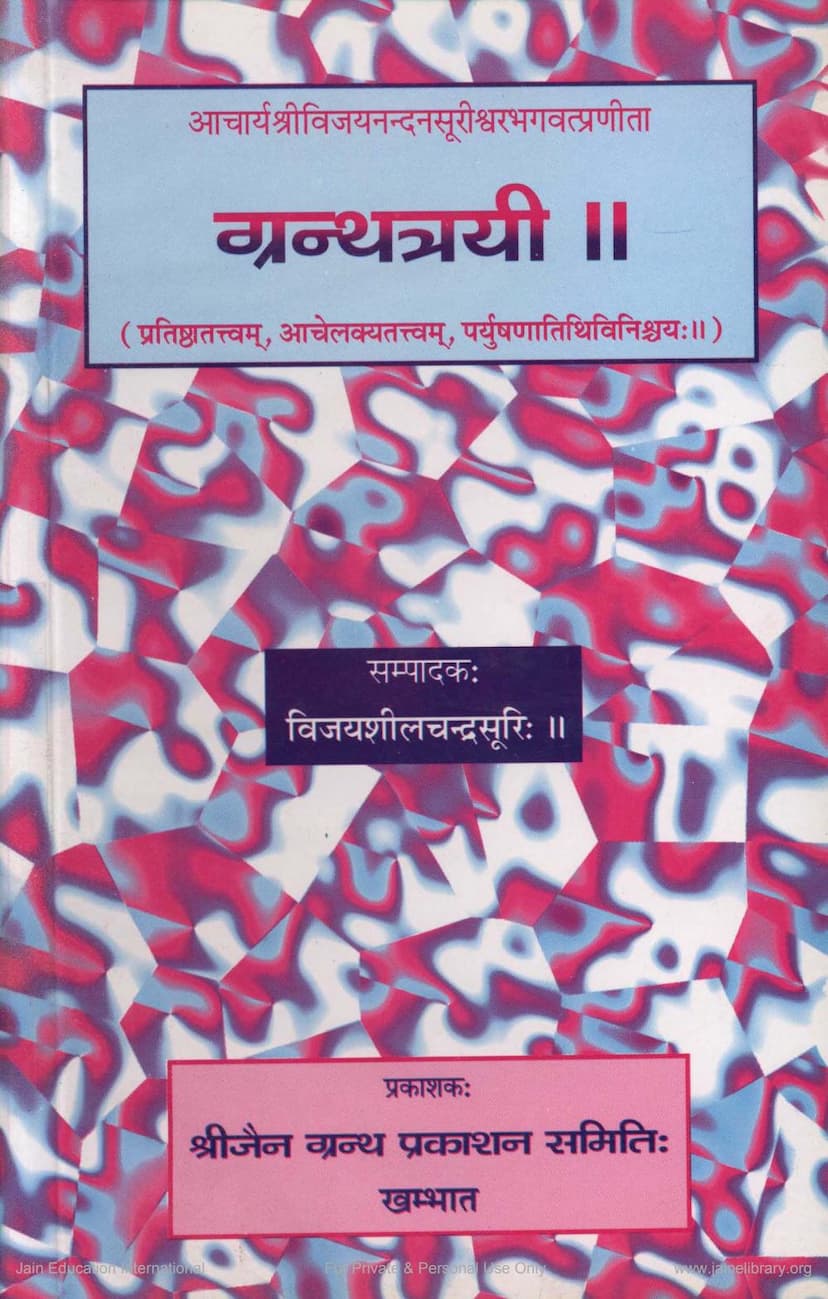Granthtrai
Added to library: September 1, 2025

Summary
Here's a comprehensive summary of the Jain text "Granthtrai" by Acharya Shri Vijayanandsuri, edited by Vijayashilchandrasuri, based on the provided catalog link and pages:
Granthtrai (The Trio of Texts)
- Author: Acharya Shri Vijayanandsuri
- Editor: Vijayashilchandrasuri
- Publisher: Shri Jain Granth Prakashan Samiti, Khambhat
- Publication Year: V.S. 2055 (1999 CE), coinciding with the birth centenary year of Acharya Shri Vijayanandsuri.
"Granthtrai" is a collection of three significant, previously unpublished Jain philosophical and ritualistic texts authored by the esteemed Acharya Shri Vijayanandsuri. The publication of these works is dedicated to his memory and was inspired by the installation (Pratishtha) of deities at the Nandanvan Tirth (Tagadi) during his centenary year. The editor, Acharya Shri Vijayashilchandrasuri, is credited with compiling and editing these valuable scriptures.
The three texts included are:
-
Pratishtha-tattva (The Principle of Consecration/Installation):
- This text delves deeply into the meaning and essence of the consecration (Prana Pratishtha) of Jain idols (Jinabimba).
- Acharya Vijayanandsuri undertakes a thorough discussion, presenting various philosophical viewpoints as initial arguments (Purvapaksha). He then meticulously refutes their inconsistencies and establishes the Jain perspective on Pratishtha through scriptural reasoning and logic.
- The text also includes a detailed historical account of the Serisaka Tirth, making the discussion both philosophically profound and historically rich.
- It explores different theories regarding the spiritual potency (Shakti) that activates an idol, including concepts like inherent power (Sahaja Shakti) and acquired power (Aadheya Shakti), drawing parallels with Mimaansa and Naiyayika philosophies before establishing the Jain viewpoint.
- The author discusses the concept of presence (Sannidhi) and recognition (Pratyabhigyan) as explanations for an idol's venerability, as well as the nuanced Jain understanding of devotion (Bhakti) and inner spiritual states as the true basis for consecration and veneration.
- It critically examines various philosophical interpretations of the efficacy of Pratishtha rituals, including the concept of "Aadheya Shakti" arising from rituals and the debate on whether the "destruction" of the ritual is the cause of venerability. The author discusses the transformative power of spiritual practices and the importance of the devotee's internal state.
- The text highlights the miraculous powers associated with consecrated idols and holy sites, using the example of Serisaka Tirth and the experiences of Acharya Nemichen Suri.
-
Achelakya-tattva (The Principle of Non-Clothing/Acelicism):
- This text addresses a fundamental concept within Jain asceticism: Achelism, or the state of being non-clothed, which is discussed in the context of the "Achelakya Kalpa" mentioned at the beginning of commentaries on the Kalpasutra.
- The author examines the differing opinions among commentators on the nature of this Kalpa.
- He neutrally and systematically refutes these differing views based on scriptural authority and logical reasoning.
- The text emphasizes the importance of unbiased inquiry and avoiding dogmatic adherence to one viewpoint. It advocates for understanding different perspectives through the lens of Naya (standpoints) and Anekanta (non-absolutism).
- The author criticizes the tendency to become partisan without proper understanding and highlights how this can lead to disrespect for scriptures and revered figures. He guides readers to appreciate that even differing opinions might be valid from specific standpoints (Naya).
-
Paryushana-tithi-vinishchaya (Determination of the Dates of Paryushana):
- This is the most substantial of the three texts.
- It provides a detailed, scripturally supported, and tradition-based logical exposition concerning the dates of Paryushana, the principal annual festival of Jainism, and related observances like Samvatsari.
- The text specifically addresses and refutes the "new date theory" (Nava Tithi Mat) that emerged around V.S. 1992-93. This theory contradicted scriptural principles and the established traditions of learned monks (Gitaarthas) by suggesting that the observance of Paryushana could be altered or "lost" (haani/vriddhi) in the annual cycle.
- The author rigorously dismantles these dissenting opinions using scriptural evidence, tradition, logic, and rational arguments, advocating for the correct and established path of observance.
- This text serves as an invaluable guide for the Jain community (Shrisangh) in upholding the purity of their spiritual path.
Overall Significance:
The "Granthtrai" offers profound insights into core Jain doctrines and practices. Acharya Shri Vijayanandsuri's profound scholarship, logical acumen, adherence to scriptural tradition, and balanced approach are evident throughout these texts. The publication is a significant contribution to Jain literature, making accessible the deep knowledge and philosophical reasoning of a revered Acharya. The editor's dedication in bringing these unpublished works to light is highly appreciated by the Jain community.